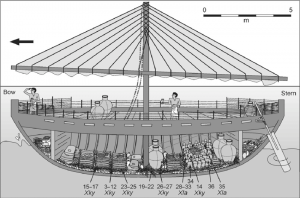Atlanteans
Amalekites
The Amalekites are usually described in encyclopedias as “a biblical people and enemy of the Israelites. They were reportedly wiped out almost entirely as the result of Israelite victories against them in wars beginning shortly after the Exodus and continuing into the period of the early Israelite monarchy(a).”
According to the Old Testament “God ordered Saul (1079-1007 BCE), King of Israel (1049-1007 BCE) to “Now go and smite Amalek, and utterly destroy all that they have, and spare them not; but slay both man and woman, infant and suckling, ox and sheep, camel and ass.” (1 Samuel 15.2-10)
The Amalekites were responsible for attacking the Israelites after the Exodus from Egypt. There is no mention of the Amalakites ever being in Egypt.
However, I therefore find it strange that many scholars, including Velikovsky, identify the Amalekites with the Hyksos who invaded Egypt in the 2nd millennium BC and ruled it for over a hundred years until defeated by the Egyptian Pharaoh Amasis I.
>Donald Keith Mills considers Velkovsky’s identification of the Hyksos as Amalekites to be deeply flawed and outlines his reasons in his paper Velikovsky and the Amalekites(e).<
Damien Mackey has noted(b) that “Dr. I. Velikovsky’s identification of the Hyksos conquerors of Egypt with the biblical Amalekites has been widely accepted by revisionists – even those who have since rejected his Ages in Chaos.
David Rohl, whose own biblico-historical revision is some centuries apart from Velikovsky’s, had nonetheless accepted the latter’s identification of the Hyksos conquerors of Egypt with the Amalekites of the Book of Exodus (Pharaohs and Kings: A Biblical Quest, 1997).
Debbie Hurn, in 2003, wrote a solid article(c) in support of this Velikovskian thesis. I thoroughly recommend that one reads her insightful article written for Testimony Magazine.”
Mackey continued with his own support for the Hyksos Amalakite identification, adding a further twist with his suggestion that the Amalakites were also known as the Amu, following the opinion of the 19th-century German Orientalist Johann Christian Friedrich Tuch and quoted by Velikovsky, endorsing it in Ages in Chaos [0039].
In March 2021, Diego Ratti published Atletenu [1821], in which he places Atlantis in Egypt, with its capital located at Avaris, better known as the capital of the Hyksos(d). He identifies Atlas as “Shamshi-Shu I: the Amorite Prince of Ugarit who in 1646 BC led a coalition of Foreign Kings to conquer Egypt starting the XV Dynasty of the ‘Hyksos’.”
So we now have the following mixture – Amalekites = Hyksos = Amu = Amorites = Atlanteans! Unfortunately, it is beyond my competence to unravel this tangle.
(a) https://www.newworldencyclopedia.org/entry/Amalekite
(b) https://mosesegyptianised.wordpress.com/2016/10/26/the-hyksos-as-amalekites/
(c) http://www.testimony-magazine.org/back/dec2003/hurn.pdf
(d) About | Atletenu (archive.org)
(e) https://www.academia.edu/97365447/VELIKOVSKY_AND_THE_AMALEKITES *
Uluburun Shipwreck
The Uluburun Shipwreck is arguably one of the most important underwater discoveries of the 20th century. It was located in 1982 not very far from the town of Kas in southern Turkey. Eleven consecutive campaigns of three to four months duration took place from 1984 to 1994 totaling 22,413 dives, revealing one of the most spectacular Late Bronze Age assemblages to have emerged from the Mediterranean Sea(a). Because the wreck lay at a depth of 44-61 metres divers could only spend a very limited time  working on it, hence the large number of dives involved.
working on it, hence the large number of dives involved.
Radiocarbon dating techniques and the presence of identifiable pottery types place the date of the wreck as sometime in the late 14th century BCE, probably between 1330 and 1300 BCE.
>Peter James wrote a highly critical paper regarding the dendrochronological dating of the Uluburun shipwreck explaining “why the Uluburun date is dubious in the extreme and how its status as a ‘scientific’ date has gradually unravelled”(e).<
The main cargo of the ship was raw materials. The largest items were copper ingots, 348 of them, totalling 10 tons in weight. These took the form of ‘oxhide’ and circular buns, which refers to the shape they had, forms common in the Bronze Age Mediterranean(b). Isotope analysis revealed the ingots were pure copper and from Cyprus(c). Additionally, the cargo included a ton of tin ingots. These metals were estimated to be enough to make 5,000 bronze swords.
It did not take long before this discovery generated some wild speculation J.S. Wakefield & Reinoud DeJonge proposed that the Uluburun copper had come from the Michigan mines in their book Rocks & Rows, Sailing Routes across the Atlantic and the Copper Trade [760]. The late Gavin Menzies went further and proposed that not only was the Uluburun copper from Michigan but that it had been brought from America by the Minoans identified by him as Atlantean.
Now that exploration of the wreck has finished, scientists are engaged in a study of the amazing array of artefacts salvaged. Articles in 2022 and(d) 2023(f) revealed some of the unexpected discoveries made, including the source of the tin ingots.
(a) https://en.wikipedia.org/wiki/Uluburun_shipwreck
(b) https://www.worldhistory.org/Uluburun_Shipwreck/
(c) Isotope analysis reveals origins of Uluburun shipwreck cargo | The Past (the-past.com)
(e) https://www.centuries.co.uk/uluburun.pdf *
(f) https://www.re-thinkingthefuture.com/2023/02/18/a9360-lost-in-time-uluburun-shipwreck/ *
